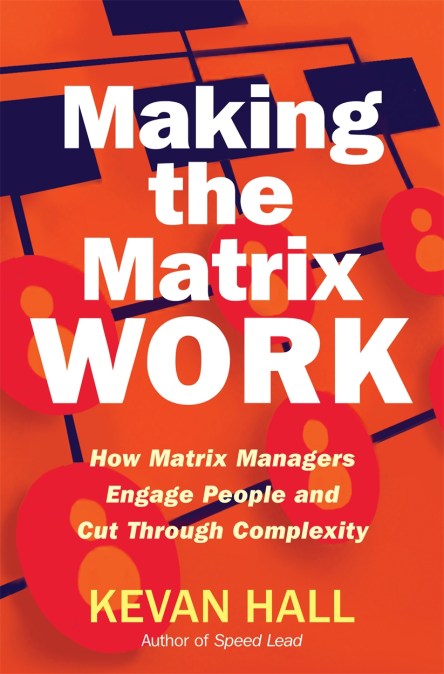We have updated our Privacy Policy Please take a moment to review it. By continuing to use this site, you agree to the terms of our updated Privacy Policy.
Making the Matrix Work
On sale
7th February 2013
Price: £20
Global customers, supply chains and more integrated business functions mean that work now cuts across the traditional vertical silos of country and function. But the ‘solution’ of the matrix structure also brings multiple bosses, competing goals and higher levels of complexity. Traditional management training prioritizes clarity, predictability and control.
In a matrix we need to be able to balance this with the ability to tolerate ambiguity, manage uncertainty and decentralize control. Managers need an expanded toolkit to help them move from the hard to the soft, from the concrete to the ambiguous and back again depending on the situation. Making the Matrix Work introduces some new ideas and practical tools in 3 key areas:
* Leading people beyond clarity to flexibility A matrix trades clarity for flexibility. We need to create enough clarity on goals and roles and to align with others; but we also need to cope with ambiguity, manage complex trade-offs and dilemmas and deal with higher levels of conflict.
* Being connected and effective We set up a matrix to improve cooperation and communication across the silos but be careful what you wish for! It is easy to become over-connected to poor quality meetings, teams and communication. More teamwork, meetings and emails are not the answer.
* Creating control by giving it away. The complexity and diversity of the matrix can undermine trust and lead to an increase in central control and bureaucracy. We need to prevent this by building trust, empowering and creating commitment. Accountability without control and influence without authority are the norm.
Kevan Hall’s new book will help you develop your matrix mindset and will show you how to establish and engage networks that do not depend on role, control or authority to get things done. This book gives individuals working in the matrix the tools to take control of their own goals, role and success and shows matrix managers how to lead others to make their matrix really work.
Watch for the author’s new book Kill Bad Meetings – coming soon.
In a matrix we need to be able to balance this with the ability to tolerate ambiguity, manage uncertainty and decentralize control. Managers need an expanded toolkit to help them move from the hard to the soft, from the concrete to the ambiguous and back again depending on the situation. Making the Matrix Work introduces some new ideas and practical tools in 3 key areas:
* Leading people beyond clarity to flexibility A matrix trades clarity for flexibility. We need to create enough clarity on goals and roles and to align with others; but we also need to cope with ambiguity, manage complex trade-offs and dilemmas and deal with higher levels of conflict.
* Being connected and effective We set up a matrix to improve cooperation and communication across the silos but be careful what you wish for! It is easy to become over-connected to poor quality meetings, teams and communication. More teamwork, meetings and emails are not the answer.
* Creating control by giving it away. The complexity and diversity of the matrix can undermine trust and lead to an increase in central control and bureaucracy. We need to prevent this by building trust, empowering and creating commitment. Accountability without control and influence without authority are the norm.
Kevan Hall’s new book will help you develop your matrix mindset and will show you how to establish and engage networks that do not depend on role, control or authority to get things done. This book gives individuals working in the matrix the tools to take control of their own goals, role and success and shows matrix managers how to lead others to make their matrix really work.
Watch for the author’s new book Kill Bad Meetings – coming soon.
Newsletter Signup
By clicking ‘Sign Up,’ I acknowledge that I have read and agree to Hachette Book Group’s Privacy Policy and Terms of Use
Reviews
The book is accessible, easy to read and practically written...I found the book gave me cause to examine how I manage, and I was able to take away some practical ideas that I will apply in my own working environment.
Intensely practical. Hall's book is a highly stimulating guide to creating a more efficient business. Any global firm would benefit form the chapter on managing across time zones by organising continuous 24-hour working.
An eminently practical book, good at giving pragmatic, realistic tips that can help the reader to reframe and reflect on one's practice, and change behaviour without the guilt from being 'stuck' in an outdated managerial mindset. This is a well-organised and enthusiastic synthesis of good managerial practice.
We want our companies to be faster, simpler and easier to run - this refreshing blend of challenging ideas and practical tools shows us how.
A much needed new look at managing and leading in complex modern organisations. Practical tools you can implement to speed up your company.
Speed is the key word for companies in the Asia Pacific Rim. Kevan's remarkable...book comes from his long practical experience. New tools and techniques from this book can be applied in many different countries without any cultural difference.
Globalization, technology and scale can lead to growth and success, but they also bring dysfunctional baggage. Kevan shows how to get off the organizational 'hamster wheel' and focus on what is important.

